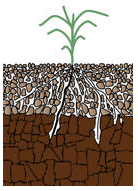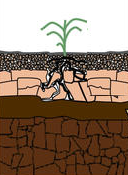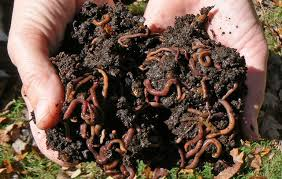Science > Biology > Soil Management > Testing of Soil on Farm Methods
Need for Testing of Soil:
- To optimize crop production
- To protect the environment from contamination by runoff and leaching of excess fertilizers
- To aid in the diagnosis of plant culture problems
- To Know the exact nutrient found in the Soil
- To improve the nutritional balance of the growing media
- To save money and conserve energy by applying only the amount of fertilizer needed.
- To Find the nature of the soil.
Simple Methods of Testing of Soil
Soil Structure and Tilth:
Soil structure refers to the grouping of soil components (the mineral component, organic matter, and fertilizers) into porous compounds called aggregates, which are then arranged into larger units called peds, separated by pores and cracks.
The condition of tilled soil, especially with respect to the suitability for sowing seeds is called the tilth. It is important to determine whether the soil is of the right tilth. Good tilth enables roots to expand freely and facilitates absorption of water, oxygen, and nutrients easily. Good tilth soil is water-efficient, i.e. less water is needed to reach plant roots. Similarly, runoff water loss is reduced because water is absorbed faster and held better.

Method of Testing:
- When the soil is neither too wet nor too dry, dig a hole about 10 inches deep.
- Separate an intact section about the feast size and try to break it apart with your fingers.
- Feel the texture and determine whether the soil is cloddy, powdery, or granular.
- Difficulty in breaking indicates that the soil is hard. The soil should be made up of different sized crumbs that can hold their shape under slight pressure created by the fingers.
Compaction:
Compaction of soil is the pressing of soil particles close to each other by mechanical methods. Air during compaction of soil is expelled from the void space in the soil mass and therefore the mass density is increased. Compaction of soil is done to improve the engineering properties of the soil. Compaction of soil is required for the construction of earth dams, canal embankments, highways, runways, and many other structures. It is required in agriculture to check penetrability of water in the soil. Good soil contains a network of pores that occupy 50% of its volume. When fully charged with water, the pore space in good soil will be roughly half-filled with air and half with water. Compacted soil inhibits root growth and water availability, and keeps earthworms and other vital soil fauna from circulating freely.

Method of Testing:
- Plunge a wire flag vertically into the soil at different locations.
- Mark the depth at which the wire starts bending.
- The sooner it bends, the more compacted the soil.
- A penetration of wire to the extent of one foot or more shows the soil is easily penetrable.
Trafficability and Workability:
Trafficability and workability are soil capabilities supporting operations of agricultural machinery. Trafficability is a soil capability supporting agricultural traffic without degrading soils and ecosystems. Farmers measure trafficability by monitoring how much tractor fuel they use. Workability is a soil capability supporting tillage. Workable soil allows water to reach roots efficiently and it’s less prone to compaction. If tilling or digging the soil produces cloddy or plate-like clumps, the workability is low.
Method of Testing:
- Dig down a 10-inch hole into the soil and gather a handful of soil.
- Gently compress the soil into a ball with one hand.
- Toss the ball 6 inches into the air and let it fall into an open hand. If the ball falls apart into crumbs, the soil is ready to work; if it stays as a ball or only comes slightly apart, more drying time is necessary.
- Soil should pass this test because if the soil fails this test there is most likely that soil will fail other tests.
Soil Organisms:
The whole mass of living organisms in soil is called its microbial biomass. A thriving population of diverse fungi, bacteria, insects, and invertebrates is one of the most visible signs of soil quality.

Method of Testing:
- Dig a hole of about 6 inches into the soil.
- Observe inside of the hole carefully for about 5 minutes. The soil organisms dislike daylight. They come out. Count the number and species of each organism observed, such as centipedes, ground beetles, and spiders.
- If the count is less than 10, the soil does not have enough active players in the food chain. It indicates that the amount of carbon, nitrogen, phosphorus or sulphur that is present in the soil is less.
Earthworms:
One common measure to check soil health is the number of earthworms that are found in the field. To survive, earthworms need moist soils that have sufficient residue or organic matter for food. Earthworms aerate the soil and also increase the penetrability of water. Their castings infuse the soil with enzymes, bacteria, organic matter, and plant nutrients. They secrete compounds that bind soil particles together for better tilth. Hence earthworm is called the “Farmer’s Friend”.

Method of testing:
- When the soil is not too dry or wet, check the soil surface for earthworm castings and burrows.
- Dig out 6 inches of soil and count the number of earthworms present in it. The absence of worms means the soil does not have enough of the organic matter they feed on. More than three earthworms show the soil is of good quality.
Plant Residue:
The single most important component of healthy soil is organic matter. Plant residue analysis is important for evaluating the nutrient status of soils and crops, as on the basis of the results, the decision on the quantity of fertilizers required can be taken. During analysis, the speed of decomposition of plant matter in the soil is determined. Fast decomposition is an indicator of soil quality. In poorly aerated soil, plants break down slowly.
Method of Testing:
- Turn down cover crop taken into the soil for some part of your field.
- After one month dig down 15 cm deep into the soil and look for plant matter. The presence of recognizable plant parts, as well as plant fibers and darkly colored humus, indicates an ideal rate of decomposition.
Water Availability and water Holding Capacity:
How much water a soil can hold is very important for plant growth. Soils that can hold a lot of water support more plant growth and are less susceptible to leaching losses of nutrients and pesticides. Available water is the difference between field capacity which is the maximum amount of water the soil can hold and the wilting point where the plant can no longer extract water from the soil. Porous soil can better resist evaporation and adequately supply plants between watering.

Method of Testing:
- Wait till the soil is soaked with rain water.
- Measure time until plants start to show signs of thirst.
- If plants require more frequent watering than typical then the water holding capacity of soil is low.
Water Infiltration:
Good penetration of water makes water available to plants when they need it and prevents runoff and erosion of soil
Method of Testing:
- Take a plastic or metal barrel of about 3inch diameter and 6 inches long and push it into the soil such that about 3 inches of it remain above the soil surface.
- If the penetration of water in the soil is less than 2 inch an hour then the soil is compact and its quality for agriculture is low.
Plant Root and Overall Plant Development:
Plant vigor indicates soil with good structure and tilth, a well-regulated water supply, and a diverse population of organisms. It’s the best sign of effective soil management you’ll have above ground. Roots are good indicators of soil quality. In the absence of air, water, biological activity, and crumbly soil the proper development of root cannot take place.

Method of Testing:
- Properly and carefully dig out a selected plant, preferably a weed you won’t miss.
- Check the extent of root development
- Fine strands with a white healthy appearance show good development of root.
- Brown stunned roots indicate disease or the presence of root-gnawing pests.
The methods of testing of soil discussed above can be used by anybody, for proper testing of soil laboratory methods are used. These methods of testing of soil are cheap but are effective. Laboratory testing of soil includes measuring soil pH, the macronutrients nitrogen, phosphorus, and potassium, and salinity.
